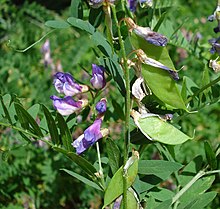Kassuben vetch
| Kassuben vetch | ||||||||||||
|---|---|---|---|---|---|---|---|---|---|---|---|---|

Cassube vetch ( Vicia cassubica ) |
||||||||||||
| Systematics | ||||||||||||
|
||||||||||||
| Scientific name | ||||||||||||
| Vicia cassubica | ||||||||||||
| L. |
The Kassuben-Wicke ( Vicia cassubica ) is a species of the genus Wicken ( Vicia ) in the subfamily of the butterflies (Faboideae) within the family of the legumes (Fabaceae). It is only widespread in parts of Central Europe. The name Kassuben-Wicke goes back to Kashubia .
description
Habit and leaves
The Kassuben vetch is a perennial herbaceous plant with knotty, creeping basic axis and short, thick bottom runners. The mostly single stem is simple or branched, mostly upright, more rarely prostrate or climbing, 30 to 60 cm long, angular and, like the leaves, more or less short and softly hairy to balding.
The alternate leaves are about 5 to 13 cm long, pinnate in pairs, with usually weak, simple or knotty tendrils and nine to eleven pairs of leaflets . The short-stalked leaflets are elliptical to oblong-lanceolate, about 12 to 15 mm long and 5 to 7 mm wide, mostly rounded and provided with sharply defined tips. They have numerous, reticulated lateral nerves that extend at an angle of about 45 degrees, are cloudy green, hairy to completely bald on both sides. The stipules are somewhat narrower than the stem, half-arrow to half-spear-shaped and usually with entire margins.
Inflorescences and flowers
The racemose inflorescences are about 5 to 8 cm long, shorter to as long as the leaves, more or less clearly one-sided and have ten to twelve flowers. The flower stalks have a length of 2 to 3 mm. The zygomorphic flowers are 9 to 12 mm long. The chalice is bell-shaped, crooked and has short teeth. The upper ones are short triangular, the lower ones sub-sub-like and at most as long as the tube. The petals are of a similar shape to Vicia cracca . The flag is red-violet, darker veined and a little longer than the whitish, bluish wings and the whitish, more or less purple boat in front .
The Kassuben vetch blooms in June and July.
Fruits and seeds
The legumes are clearly stalked, about 1.5 to 2.5 cm long and 6 to 8 mm wide, egg-shaped, flat, glabrous, smooth and vividly maroon in color. They contain one to three seeds. The seeds are ovate-spherical, somewhat flattened, about 4 mm long, smooth, yellow-brown to olive-green in color and more or less lighter in color. The seeds of the cassube vetch are thought to be spread by chicken birds.
Chromosome number
The number of chromosomes is 2n = 12.
Distribution and site conditions
The Kassuben vetch is native to northern and eastern Central Europe to southern Scandinavia , Russia , Ukraine , Crimea , Asia Minor , the Balkans and the Apennines . Vicia cassubica is a temperate-continental to sub-Mediterranean floral element .
The Kassuben vetch is a pontic floral element . It is believed that she immigrated from the Danube and Sudeten countries to the Oder , Elbe and Rhine regions . The occurrences in eastern Germany and southern Sweden, however, hardly have a relic-like character; here it occurs more frequently. The few occurrences in southwest Germany (Deidesheim, Wachenheim), however, are completely isolated from the main area. In Austria Vicia cassubica is found scattered or rarely, while it is completely absent in Switzerland.
The Kassuben vetch grows in dry deciduous and coniferous forests as well as on forest meadows. In Central Europe, it is a character species of the Agrimonio-Vicietum cassubicae from the Trifolion medii association.
literature
- Gustav Hegi, H. Gams, H. Marzell: Illustrated flora of Central Europe. Pteridophyta, Spermatophyta . 2nd Edition. Volume IV. Part 3: Angiospermae: Dicotyledones 2 (5) (Leguminosae - Tropaeolaceae) . Carl Hanser and Paul Parey, Munich and Berlin / Hamburg 1964, ISBN 3-489-70020-1 (unchanged reprint from 1923-1924 with addendum).
- Konrad von Weihe (ed.): Illustrated flora. Germany and neighboring areas. Vascular cryptogams and flowering plants . Founded by August Garcke. 23rd edition. Paul Parey, Berlin / Hamburg 1972, ISBN 3-489-68034-0 .
- Oskar Sebald, Siegmund Seybold, Georg Philippi (Hrsg.): The fern and flowering plants of Baden-Württemberg . tape 3 : Special part (Spermatophyta, subclass Rosidae): Droseraceae to Fabaceae . Eugen Ulmer, Stuttgart (Hohenheim) 1992, ISBN 3-8001-3314-8 .
- Wolfgang Adler, Karl Oswald, Raimund Fischer: Excursion flora of Austria . Ed .: Manfred A. Fischer. Eugen Ulmer, Stuttgart / Vienna 1994, ISBN 3-8001-3461-6 .
- Christian Heitz: School and excursion flora for Switzerland. Taking into account the border areas. Identification book for wild growing vascular plants . Founded by August Binz. 18th completely revised and expanded edition. Schwabe & Co., Basel 1986, ISBN 3-7965-0832-4 .
- Erich Oberdorfer : Plant-sociological excursion flora . With the collaboration of Theo Müller. 6th, revised and expanded edition. Eugen Ulmer, Stuttgart (Hohenheim) 1990, ISBN 3-8001-3454-3 .
Individual evidence
- ↑ Entry in Tropicos . ( Page no longer available , search in web archives ) Info: The link was automatically marked as defective. Please check the link according to the instructions and then remove this notice.
- ^ Erich Oberdorfer : Plant-sociological excursion flora for Germany and neighboring areas . 8th edition. Verlag Eugen Ulmer, Stuttgart 2001, ISBN 3-8001-3131-5 . Page 611.
Web links
- Kassuben vetch. In: FloraWeb.de.
- Kassuben vetch . In: BiolFlor, the database of biological-ecological characteristics of the flora of Germany.
- Profile and distribution map for Bavaria . In: Botanical Information Hub of Bavaria .
- Distribution in the northern hemisphere from: Eric Hultén, Magnus Fries: Atlas of North European vascular plants , 1986, ISBN 3-87429-263-0
- Thomas Meyer: Data sheet with identification key and photos at Flora-de: Flora von Deutschland (old name of the website: Flowers in Swabia )
- Carl von Linné: Species Plantarum 2, 1753, p. 735 (first description)


